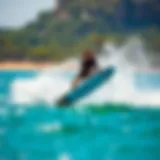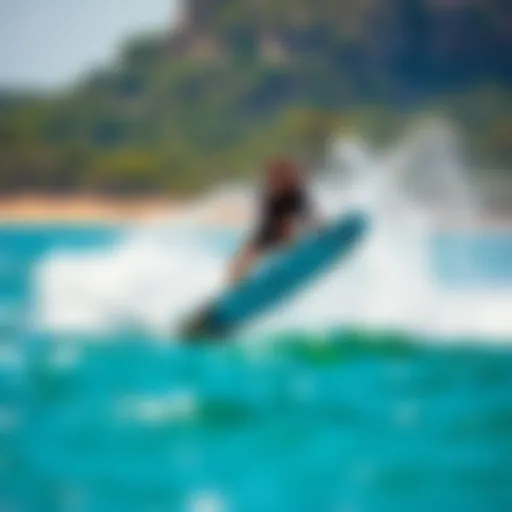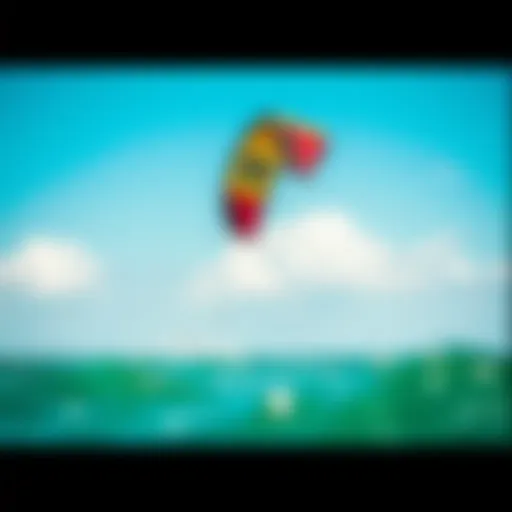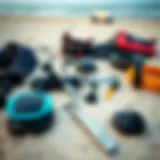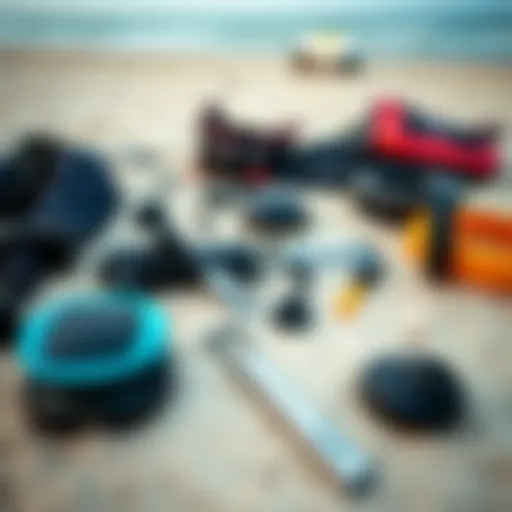Mastering the Essentials of Windsurfing Kites
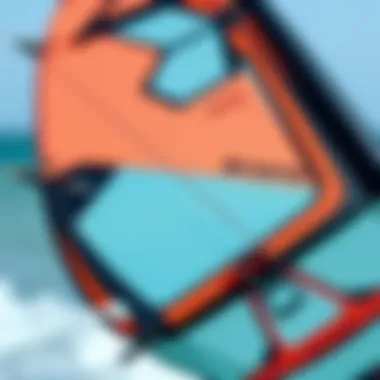
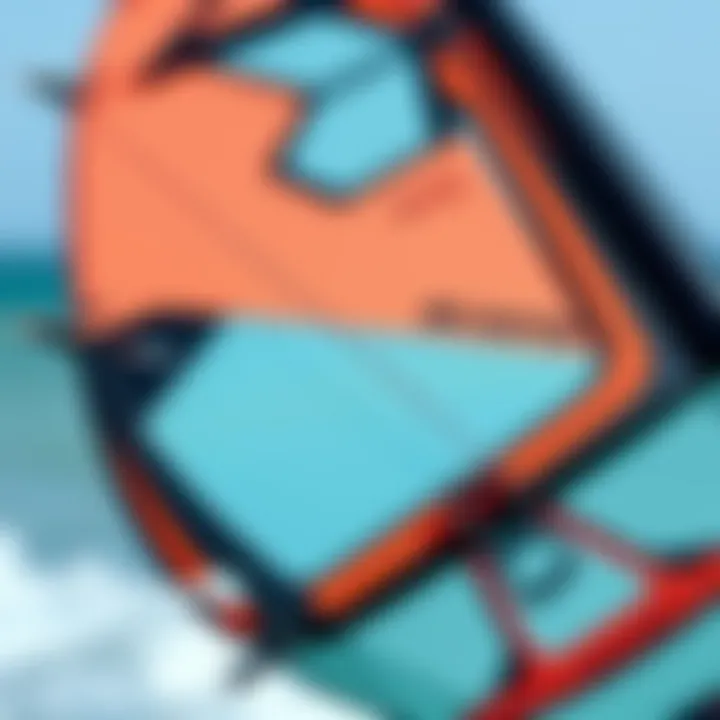
Intro
Windsurfing kites are a special blend of art and science, which take kiteboarding to a whole new level. In many ways, you can liken it to painting on waves; every stroke, every gust of wind, and every tilt of your body matters. Beginners may find the initial hurdles steep, but as one dives deeper, the allure of kiteboarding becomes undeniable. This sport draws enthusiasts from various backgrounds, all eager to catch that perfect wind, to feel the power of the kite, and to master the waves like a seasoned pro.
The world of windsurfing kites is vast, diverse, and replete with subtleties that can easily flummox newcomers. This guide serves as a roadmap, illuminating the path through various aspects from gear insights to essential techniques. Throughout this article, we will peel back the layers of gear selection, wind conditions, safety practices, and the rich culture that surrounds kiteboarding.
This exploration will equip you, whether you're a novice dipping your toes into the waters or an experienced rider looking to refine your skills.
Gear Insights
When stepping into the world of windsurfing kites, the gear you choose can either elevate your experience or be a stumbling block. This section uncovers the essentials that form the backbone of kiteboarding.
Latest Gear Reviews
The development of kite technology seems to jump leaps and bounds every year. Brands like Naish and Cabrinha continually innovate, offering kites that are lighter, more responsive, and designed to tackle varied wind conditions.
For instance, the Cabrinha Switchblade is widely praised for its versatility, catering to both freestyle and surf enthusiasts. Riders rave about how smooth it feels when slicing through the wind, making aggressive turns a breeze.
Look for kites that suit your style. If you want to cruise at high speed, a kite like the Slingshot RPM works wonders, giving a solid boost while maintaining stability. On the flip side, the Duotone Rebel excels for those focusing on freeride, maximizing potential in diverse conditions. Always check user reviews for the latest feedback, as this can save you a headache later.
Essential Gear for Beginners
For newcomers, it is crucial to start with the right equipment that fosters a fun learning experience. Here are some basics:
- Kite: A medium-sized beginner kite, around 9-12m, is recommended, as it offers a balance between power and control.
- Board: Opt for a larger board with a wide surface area. This helps with stability and buoyancy, making it easier to get up and ride.
- Harness: A comfortable harness helps distribute the kite's pull evenly, relieving pressure from your arms.
- Safety Gear: Always invest in a decent impact vest and a helmet to protect yourself in case of a tumble.
Make sure to familiarize yourself with the gear before hitting the water. Get a feel for how everything looks and operates. Practice on land if possible, and understand how to set up and pack away your kite properly.
"The kiteboarding experience is not just about the thrill of the ride but about respecting the elements and understanding your gear."
Getting used to your equipment will enhance your overall performance and keep frustration at bay. And trust me, it's worth it when you finally glide across the water, feeling the wind’s embrace.
Techniques and Tips
Mastering the art of windsurfing kites requires not only the right mindset but also robust techniques, alongside a few handy tips that can make a world of difference. Starting small is key and focusing on solid foundational skills will pay off immensely.
Advanced Tricks and Techniques
Once you've built confidence and can stay upright, it’s time to expand your repertoire. Tricks like the jump and slide-through can be exhilarating to master. Begin with the basics: try getting comfortable with jumping before moving on to spins or flips. You'll soon be strutting your stuff on the water, impressing fellow riders.
Safety Practices for Kiteboarders
Kiteboarding, while thrilling, is not without its risks. Adhering to safety measures can snatch you away from potential danger. Here are a few to keep in mind:
- Always check the weather conditions before going out.
- Perform a wind check regularly while on the water.
- Verify all equipment is in proper working condition, including lines, straps, and safety systems.
- Carry a communication device to call for help if needed.
In the end, kiteboarding isn’t just a sport; it’s a lifestyle that blends wind, water, and adrenaline into one powerful concoction. Embracing the nuances of windsurfing kites will not only enhance your performance but also your overall appreciation for this exhilarating activity. The thrill of riding that perfect wave, feeling the wind at your back, and the roar of water below is simultaneously sublime and addictive.
Prologue to Windsurfing Kites
Windsurfing kites play a crucial role in the exhilarating sport of kiteboarding. Understanding the intricate components of this equipment not only enhances performance but also enriches the overall experience on the water. As the bridge that connects a rider to the wind, kites are more than just sails; they're the very essence of kiteboarding, dictating how well one can maneuver through different conditions.
Understanding Kiteboarding
Kiteboarding merges surfing, snowboarding, and windsurfing into one thrilling sport. At its core, it employs a power kite to harness wind energy, allowing riders to glide over water. What sets kiteboarding apart is the utilization of a board, akin to a surfboard, which offers various styles from freestyle to speed riding.
Kiteboarding is not merely a physical activity; it's an art that calls for a blend of grace, timing, and an acute understanding of nature's elements. Riders must develop an intuitive sense of how kites interact with wind currents. For instance, a beginner might struggle with the kite falling out of the sky when they don't control the lines properly, whereas an experienced kiteboarder reads the wind like a seasoned sailor.
The Evolution of Windsurfing Kites
Kites have changed dramatically since their inception. When kiteboarding first made waves, kites were rudimentary, designed from basic materials that limited performance. Early models lacked efficiency and could be tricky to control, often resulting in frustrating wipeouts. Over the decades, manufacturers have focused on innovation, leading to advancements in the aerodynamics and materials of kites.
Modern kite designs incorporate lightweight fabrics, such as ripstop nylon or polyester, paired with reinforcement techniques to withstand the rigors of the sea. Different shapes have emerged, from hybrid kites that blend features of inflatables and foils to specialized designs tailored for high wind or light wind conditions. These evolutions have not only enhanced performance but have also expanded the sport's accessibility to a broader range of participants.
In short, understanding the evolution and technology behind windsurfing kites is essential for anyone looking to engage in kiteboarding. It not only serves as a foundation for selecting the right gear but also aids in improving one's skills on the water.
Technical Aspects of Windsurfing Kites
When diving into the world of windsurfing kites, one cannot overlook the intricate technical aspects that lie beneath the surface. These elements aren’t just details; they play a decisive role in the performance, safety, and overall experience of kiteboarding. Whether you are gliding across glassy waters or carving through choppy waves, the choice and understanding of materials, construction, and design influence how a kite behaves in the wind. This section aims to shed light on the vital components that contribute to making a kite ideal for your specific needs.
Materials and Construction
Kites are crafted from various materials, which directly impacts their performance, durability, and feel while flying.
Fabric Types
Fabric selection is perhaps one of the first considerations when discussing kite materials. Generally, kite fabrics are available in several types, with ripstop nylon and polyester being predominant.
Ripstop nylon, known for its lightweight and durable nature, offers excellent resistance to tearing, making it a popular choice among kite designers. The grid-like structure of ripstop fabric is particularly beneficial as it limits the stress of the wind on the material, ensuring that tiny rips do not turn into major failures. This characteristic is especially crucial during high-wind sessions when a single tear could send an enthusiast crashing down.
On the flip side, polyester, while heavier than nylon, can be favored for its UV resistance, making it less prone to sun damage. Kiteboarders often appreciate the balance polyester provides between weight and durability, though it may not fly as efficiently as nylon in lighter winds.
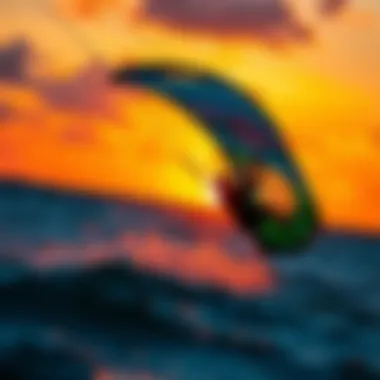
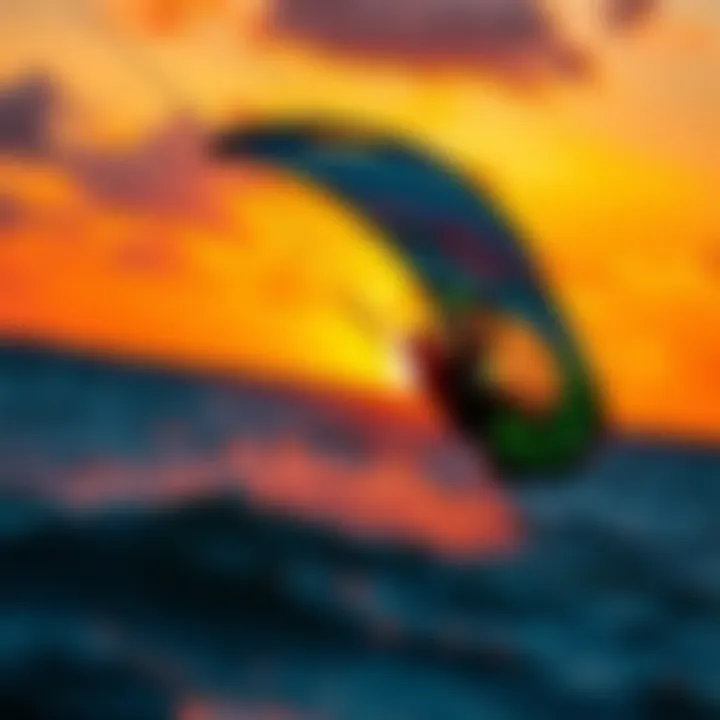
In sum, when evaluating fabric types, one must consider the trade-offs—lightweight versus durability—and match those to their riding style and typical conditions.
Reinforcement Techniques
Reinforcement in kite construction can’t be ignored. Craftsmanship in sewing and the addition of reinforcements at high-stress areas contribute directly to a kite’s longevity.
Popular techniques include tape reinforcements or additional panels added to corners and struts. These not only help absorb the kinetic energy that affects the kite during tricks but also provide stability in rough winds.
Using reinforced areas allows the kite to maintain its shape under stress, hence improving aerodynamics. While these techniques can add some weight, the benefits far outweigh any slight detriment, particularly for aggressive riders pushing their kites to the limits.
Seam Construction
Seam construction is another critical aspect that influences a kite's performance. Kites can be sewn with various seam types—flat seams, overlapped seams, or even advanced techniques like blind stitching.
Each type offers different benefits in terms of durability and airflow. Flat seams tend to lay the fabric flat, reducing drag, which improves flight characteristics. However, overlapped seams offer an increased fortification at the trade-off of added bulk.
The choice of seam construction affects not only how the kite flies but also its life span. Properly sealed seams can prevent water ingress, ensuring that the internal integrity of the kite remains intact, thus affecting overall performance during its use.
Kite Design Variations
Understanding kite design is fundamental for any kitebording enthusiast as it determines everything from flying characteristics to what conditions the kite performs best in.
Foil Kites
Foil kites are unique in their design as they do not rely on rigid structures. Instead, they utilize open cells to catch and hold air, which makes them incredibly light and efficient. This characteristic provides an advantage when flying in light winds, allowing riders to enjoy sessions that might otherwise be missed with a traditional inflatable kite.
However, the lack of structure can make them less stable in turbulent wind conditions, posing a challenge for less experienced riders.
Inflatable Kites
Inflatable kites are the warm blankets of the kiteboarding world—they are reliable, forgiving, and widely used, especially for beginners. These kites maintain their shape due to the inflatable bladders, making them excellent for jumping and providing stability in various wind conditions.
While they are overall user-friendly, they can be cumbersome when it comes to packing and transporting, as the added equipment can weigh down a kiteboarder.
Hybrid Designs
Hybrid designs, as the name suggests, blend features of both foil and inflatable kites. These kites aim to capture the benefits of both types while mitigating their disadvantages. They can perform well in a range of conditions and cater to a diverse group of riders, from casual to advanced.
However, striking the perfect balance between features from both designs can be a complex task, and some kiteboarders find that they may need to compromise on specific performance metrics.
Wind Conditions and Their Impact
Understanding wind conditions is crucial for kiteboarders, whether you're just starting or have many years under your belt. The wind is the lifeblood of any kiteboarding session. Without it, there's no ride. Therefore, getting a grasp on the nuances of wind patterns and speeds helps in optimizing performance and ensuring safety.
This section dives into the critical aspects of wind conditions, enabling enthusiasts to adapt to varying scenarios. It revolves around understanding how different types of wind can either enhance your experience or pose challenges.
Understanding Wind Patterns
Wind patterns refer to the consistent behaviors observed in wind movement at a given location. These patterns can be influenced by numerous factors such as geographical terrain, sea currents, and weather systems. For example, coastal areas may experience sea breezes that develop due to temperature differences between land and water. Amid these breezes, kiteboarders often find their ideal conditions, with winds ranging from light to strong.
Wind direction also plays a critical role. When kites are flown facing the wind, riders can effectively harness its power to propel themselves across the water’s surface. To maximize performance, kiteboarders must become familiar with local wind forecasts, relying on trusted sources, whether that be community observations or apps that specialize in weather conditions.
Adjusting to Different Wind Speeds
Different wind speeds demand various approaches to kiteboarding. Understanding these differences can elevate one’s experience or, conversely, lead to frustration and difficulties. Let's break down the nuances of three primary wind speed categories:
Light Wind
Light wind conditions typically range from 5 to 12 knots. These episodes are characterized by soft breezes that can offer unique kiteboarding opportunities. While some may find these conditions challenging due to the lack of power, they offer an opportunity for grace and finesse. Riders can hone their skills in balance, technique, and control. Often, large kites are the go-to choice, as they can catch even the faintest gusts.
The key characteristic of light wind is its gentleness, allowing for a more relaxed experience. However, the downside to light winds is that they can lead to prolonged periods of waiting for gusts to catch your kite, which can be disheartening. Performance may decrease significantly if the kite fails to catch enough wind or if the rider is overpowered, leading to inefficient movement.
Medium Wind
Medium wind conditions generally range from 12 to 20 knots. This range is often touted as the sweet spot for many kiteboarders, offering the perfect blend of power and control. Kites in this category are typically smaller, more responsive, and provide riders with the ability to perform tricks and maneuvers with greater precision. The dynamic nature of the wind allows kiteboarders to enjoy a more exhilarating ride without feeling overwhelmed.
Medium winds are alluring to both beginners and seasoned riders for their versatility. This balanced wind can support various tricks, from jumps to complex carves, making it an enjoyable spectrum for many. However, it is also essential to understand your kite’s limits and how your skills align with the wind’s behavior to avoid mishaps.
High Wind
High wind conditions kick in at 20 knots and above. These winds can be exhilarating, but they require a skilled hand. Fewer riders may enjoy this speed, as it demands a more advanced understanding of both kite handling and personal safety. Smaller kites are preferred during high winds to minimize overstress on the equipment and to maintain better control.
The key characteristic of high winds is their intensity, posing significant challenges and opportunities alike. They can lead to stunning jumps and fast rides, but risk factors also leap considerably. Without appropriate precautions, novices can feel out of depth, leading to accidents or equipment failure. Understanding how to navigate high winds will ultimately contribute to a rewarding adventure, and riders must be vigilant about their ability levels and the kite’s responsiveness relative to the conditions.
In summary, recognizing and adapting to the varied wind environments is essential for kiteboarding success. The more informed you are about these conditions, the better prepared you will be to seize the opportunity for an enjoyable and exciting ride.
Safety Considerations
When engaging in the exhilarating sport of kiteboarding, the need for stringent safety measures can’t be overstated. Understanding the nuances of safety considerations forms a foundational aspect of one’s kiteboarding experience. Not only do these precautions help prevent injuries, but they also instill confidence in practitioners, allowing them to focus on mastering their skills while enjoying the wind and water.
Essential Safety Gear
Effective kiteboarding demands proper safety gear, which plays a crucial role in protecting oneself from potential accidents on the water. Let's delve into the key components of essential safety gear and their significance.
Harnesses
Harnesses serve as a pivotal element in kiteboarding safety. Primarily designed to distribute the force from the kite throughout the body, harnesses allow riders to maintain control without straining their arms. One of the standout characteristics of harnesses is the comfort they offer; a well-fitted harness wraps snugly around the waist or hips, ensuring optimal support during those thrilling rides.
A popular choice among kiteboarders is the seat harness due to its superior lower back support. Unlike other types of harnesses, the seat design helps keep your body aligned and stable, particularly in challenging conditions. The unique feature here is the bottom support, which reduces pressure on the lower back, an area prone to fatigue during extensive sessions. However, some may find the seat harness less favorable in terms of maneuverability compared to the waist harness, which tends to allow for more freedom of movement.
Helmets


Helmets are vital for protecting the head from unexpected impacts, which can often happen due to high-speed crashes or sudden changes in wind conditions. A good helmet is lightweight yet sturdy, ensuring that riders can remain agile without compromising safety. The key characteristic of these helmets is their design, where an inner foam lining absorbs impact effectively.
One unique feature of some helmets is the added ear protection, especially useful in strong winds or cold water conditions. This feature helps shield the ears from harsh weather and potential injuries caused by kite lines or other gear. However, some helmet styles may lack ventilation, which could lead to overheating during long sessions. Therefore, selecting a helmet with proper ventilation is advisable, striking a balance between safety and comfort.
Impact Vests
Impact vests are an excellent addition to any kiteboarder’s safety arsenal. These vests are engineered to cushion the body against sudden falls and impacts, making them essential for both beginners and advanced riders. A key characteristic of impact vests is their buoyant properties; many are designed to help keep the rider afloat while providing essential protection.
One unique feature of some impact vests is the segmented foam, which allows for flexibility and unrestricted movement. This means you can enjoy your rides without feeling overly constricted, a common complaint among those who use bulkier flotation devices. On the downside, not all impact vests provide adequate buoyancy, so it’s key to consider the fit and buoyancy aspects when making a selection.
Common Risks in Kiteboarding
While kiteboarding is a thrilling sport with numerous rewards, it is not without its risks. Understanding these risks prepares riders to handle potential scenarios more effectively.
Some common risks include:
- Equipment Failure: Poorly maintained gear can lead to precarious situations. Regularly checking lines, kites, and harnesses is critical to prevent malfunctions.
- Environmental Hazards: Changes in wind speed and direction can create dangerous conditions, making it essential to keep an eye on weather reports and local wind patterns.
- Collisions: It’s important to be aware of surrounding kiteboarders and potential obstructions like boats or swimmers in the water. Maintaining a safe distance helps minimize this risk.
"Safety isn’t just a priority; it's a necessity for anyone who wants to fully enjoy kiteboarding."
By incorporating the right safety gear and maintaining awareness of common risks, kiteboarders can significantly enhance their overall experience on the water.
Selecting the Right Windsurfing Kite
Choosing the right windsurfing kite is pivotal for anyone looking to enjoy kiteboarding, whether you're just starting out or have been riding the winds for years. The right kite can make or break your experience. Each kite comes with its unique characteristics and benefits, which can significantly influence performance, safety, and overall satisfaction while on the water. This section dives into the essentials of kite selection, taking into account various influencing factors, like skill levels, personal preferences, local conditions, and riding styles.
Evaluating Skill Levels
Beginners
Beginners oftentimes find themselves overwhelmed with options when it comes to selecting their first kite. Typically, those just starting are attracted to kites that are user-friendly and forgiving. These kites feature larger surface areas, which help in generating lift even in lighter winds. A key characteristic of beginner kites is stability; they generally maintain a steady flight path which can instill confidence in new riders.
The advantage of beginner kites lies in their ease of control. However, they may lack the performance capabilities of more advanced models, making it essential for beginners to recognize that while they are good for starting, as skills improve, a different kite may be needed.
Intermediate
As riders progress to an intermediate level, the dynamics of kite selection change. Intermediate kiteboarders usually seek kites that offer a balance of performance and stability. At this stage, riders begin to try out more complex maneuvers and require kites that can handle a range of wind conditions.
The defining characteristic of intermediate kites is versatility; they cater well to both freeride and freestyle styles. However, the downside might be the learning curve that comes with more advanced features. Riders may find themselves wrestling with power control and maneuverability, but these challenges help build significant skills.
Advanced
Advanced kiteboarders are an entirely different breed. They often seek high-performance kites that excel in speed, control, and responsiveness. These kites are crafted for specific styles—be it racing, big air, or wave riding. A notable feature is their responsiveness to rider input, allowing seasoned kiteboarders to push the limits of performance.
While advanced kites provide unparalleled experiences, they also carry certain risks. The high power demands and agility can be intimidating to those without sufficient experience. Thus, advanced kites require a skilled handler who understands the risks involved in high-speed scenarios.
Factors Influencing Kite Selection
Personal Preferences
Selecting a kite based on personal preferences is just as crucial as considering skill level. Every rider has different tastes, and what one person finds comfortable may not work for another. From color schemes to aspects like bar feel and kite weight, these traits can make a significant difference in enjoyment during sessions.
The unique aspect of personal preferences is the subjective nature of how a rider feels with their gear. Riders may prefer kites that align with their style or match their physical attributes. A kite that feels right can help build confidence but may not always match the ideal performance parameters.
Local Conditions
Weather conditions can vary widely, and local environments significantly influence kite selection. Wind patterns vary by region, and some areas might have consistent strong winds, while others offer lighter breezes. Knowing your local conditions can help in making a wise kite choice that suits your nearby waters.
Typically, local conditions are known for shaping the riding experience. A kite suited for gusty conditions won’t perform well in steady winds, and vice versa. Riders should always account for local nuances, making it easier to thrive on the water regardless of changing circumstances.
Type of Riding
Different styles of riding require different attributes in a kite. Freestyle, freeride, or wave riding all demand kites designed specifically for those experiences. Understanding one’s riding style not only boils down to the shape of the kite but also to its response in the air.
The advantages of selecting a kite based on riding style include enhanced performance and more enjoyable experiences. Kites made for wave riding, for example, can cut through water efficiently while kites for freestyle often allow for agile jumps. Each style has its own quirks that riders must learn to navigate.
Understanding these factors can lead to a better kiteboarding experience, aligning the rider’s desires with the kite design, ultimately enhancing the overall enjoyment and safety on the water.
Choosing the right kite isn’t just a matter of specs; it’s a mix of personal taste, environmental awareness, and understanding one’s own comfort and skills. By harmonizing these elements, kiteboarders can look forward to rewarding kitesurfing adventures.
Kiteboarding Techniques
Kiteboarding techniques form the backbone of this exhilarating sport, enabling practitioners to harness the power of the wind effectively. Mastering these techniques is not just about flamboyant maneuvers; it influences safety, control, and overall enjoyment on the water. As wind conditions and kite types vary, so do the skills required to navigate successfully. Gaining proficiency in techniques allows kiteboarders to push their limits while also ensuring they can manage unexpected changes in wind or water conditions.
Starting and Stopping
Starting and stopping are foundational elements in kiteboarding. The initiation of movement involves what is often referred to as the "water start." This technique is crucial as it helps the rider gain the necessary speed to lift the board out of the water. Proper stance and kite position are key here. A significant aspect is understanding how to control the kite's power while keeping the balance. Appropriate timing between the kite's traction and your weight shifting is paramount. Conversely, mastering the stopping technique—whether by slowing down gradually or performing a controlled crash landing—ensures safety and optimal kite control.
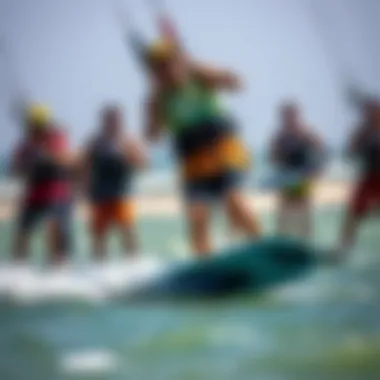
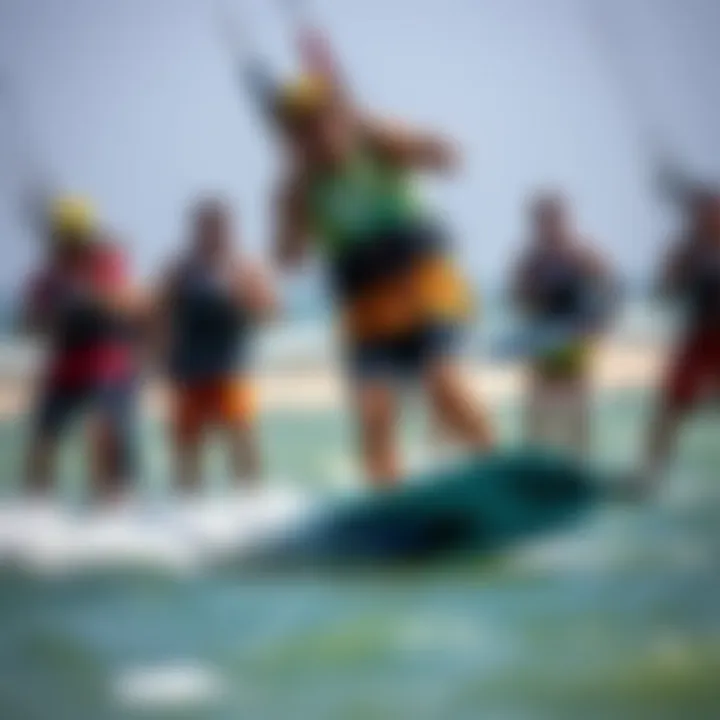
Turning and Maneuvering
Turning and maneuvering is where fun truly begins. It involves the art of changing direction while maintaining speed and balance. This can be categorized into various advanced techniques like jibing, tacking, and carving. Each method carries its unique flair and application.
Jibing
Jibing is an essential maneuver that allows kiteboarders to switch direction while riding downwind. This technique involves a smooth transition wherein the rider shifts their weight and the kite's direction in a coordinated manner. What makes jibing a popular choice is its fluidity; once mastered, it can feel almost like an extension of your body, offering a great sense of control over the kite. A unique feature here is the power control involved; adjusting the kite's position correctly maintains speed throughout the turn, making it less of a struggle and more of an effortless glide.
On the downside, improper technique in jibing can lead to a sudden loss of speed or even cause the kite to stall, which happens when the kite loses its aerodynamic efficiency. One must remember that practicing jibing often is prudent to enhance confidence and mitigate risks.
Tacking
Tacking, unlike jibing, allows riders to turn against the wind. This technique emphasizes agility and technique, requiring a precise movement as the rider moves the kite from one side to the other. A key characteristic of tacking is its versatility; it’s not just useful for changing direction but also serves as a method to navigate through challenging wind conditions. What stands out in tacking is the rider's ability to maintain momentum, even in light winds, thus making it a solid choice for diverse conditions.
However, tacking can be somewhat more technical compared to jibing and may pose challenges for beginners. The need for adequate practice to ensure understanding of weight shifting and kite control means that novice riders should approach this with patience.
Carving Techniques
Carving techniques elevated riding to an art form. Carving involves making sharp turns while maintaining speed and control. The essence of carving lies in the smoothness of the curve and the angle at which the rider enters the turn. This technique offers thrill and style, showcasing one’s agility and balance. Riders often find themselves enjoying this maneuver as it can be exhilarating and rewarding to pull off a perfect carve.
A notable advantage of carving is its contribution to speed control; proper carving can increase stability and confidence. However, it can also be tricky to master as it requires excellent kite positioning and balance to execute effectively. One must be wary of overcommitting to a turn, which could lead to crashing.
Key Takeaway: Mastering kiteboarding techniques is essential for safety, enjoyment, and skill development. Techniques like jibing, tacking, and carving not only enhance performance but also boost confidence on the water.
For more tips and resources on kiteboarding, visit Wikipedia on Kiteboarding or check out KiteForum.
Additionally, following local kiteboarding communities on platforms like Facebook and forums like Reddit can provide invaluable insights and support.
Global Kiteboarding Culture
Kiteboarding is more than just a sport; it represents a lifestyle, a community, and an evolving culture that connects enthusiasts from various corners of the world. This section examines the essence of global kiteboarding culture, highlighting its significance and the unique contributions it makes to the sport. By understanding this cultural landscape, practitioners can appreciate the shared experiences and traditions that enrich their kiteboarding journeys.
Popular Locations for Kiteboarding
Top Destinations
When it comes to kiteboarding, certain places shine brighter than others. Top destinations such as Cape Hatteras in North Carolina, Tarifa in Spain, and Maui in Hawaii are renowned for their favorable wind conditions and stunning backdrops. These sites offer both novices and seasoned riders an exciting environment to hone their skills. The unique feature of these locations is the convergence of ideal wind, flat water, and wave conditions, making them prime spots for all types of kiteboarding activities.
These locations not only provide breathtaking scenery but also draw large communities of kiteboarders, fostering a rich culture around the sport. However, travelers should also consider the fact that peak seasons can lead to crowded beaches, which could detract from the ideal kiteboarding experience.
Cultural Significance
The cultural significance of kiteboarding is palpable in its popularity. It’s about more than riding the waves; it’s a communal activity that brings people together, blending different cultures through shared passion. Events in these hotspots not only serve as competitions but also as festivals, celebrating local traditions and lifestyles.
For example, the annual Tarifa Kite Festival not only showcases skills but also promotes local artistic expression and community spirit. The advantage of these cultural gatherings is that they provide a platform for kiteboarders to exchange techniques and connect with diverse groups of people, thereby enriching the sport itself.
Local Communities
The local communities around kiteboarding hotspots play a vital role in welcoming newcomers and providing support. They offer invaluable insights into local conditions, safety practices, and the best spots to ride. These communities often have organized groups or clubs that help maintain the environment and promote responsible kiteboarding.
The unique characteristic of these communities is their collective knowledge; they can guide beginners through their first rides and share advanced tips with experienced riders, fostering an environment of continuous learning and improvement. However, while local support is beneficial, newcomers must also remember to respect local customs and the natural landscape to maintain harmony.
Kiteboarding Events and Competitions
Kiteboarding events and competitions are crucial in shaping global kiteboarding culture. From local challenges to international contests like the Professional Kiteboard Riders Association (PKRA) tour, these events highlight skill, talent, and the spirit of competition among riders worldwide. They create an atmosphere of excitement and anticipation, showcasing the athleticism and artistry involved in kiteboarding.
These gatherings also serve as melting pots for cultures, with participants and fans from varied backgrounds coming together to share their love for the sport. As new and innovative techniques emerge, these events become arenas for artistic expression while pushing the boundaries of what’s possible in kiteboarding.
The Future of Windsurfing Kites
The realm of windsurfing kites is not static; it moves and evolves, much like the winds that propel it. What unfolds in the future of this sport will hinge on innovation and a keen eye towards sustainability. These two aspects are crucial not just for the advancement of the equipment, but also for ensuring that kiteboarding continues to thrive as an environmentally responsible sport.
Innovation in Kite Technology
To take a closer look at innovations, manufacturers are continually pushing the boundaries of materials and designs. Modern advancements have led to lighter, more durable fabrics which enhance performance. Some kites now incorporate computer-aided designs for improved aerodynamics, giving them the ability to react dynamically to varying wind conditions. This means that kiteboarders can expect more responsive and agile rides, offering better maneuvers and performance in both high and light winds.
- Smart Kites: Emerging tech involves kites that can measure wind speed and adjust their shape accordingly, providing an unprecedented level of control. Imagine a kite that can adapt as you carve through the waves or leap into the air, optimizing lift and reducing drag.
- Enhanced Inflation Systems: Innovations in inflatable kite designs have also progressed. New systems provide quicker and easier inflation and deflation, letting enthusiasts spend more time on the water rather than setting up.
As competition heats up, kite brands continually strive to outdo one another, so it's likely we will witness even wilder and more functional designs rolling onto the scene. The future holds scintillating possibilities that could redefine the experience of both professional and recreational kiteboarders.
Sustainability in Kiteboarding
Another vital element looking ahead is the attitude towards sustainability. As environmental concerns grow, it's imperative that the kiteboarding community adopts practices that are eco-friendly. The manufacturing process of kites is beginning to embrace renewable resources and degradable materials. Many companies are researching biodegradable fabrics that maintain performance while reducing impact on the planet.
Here are some steps the industry is taking:
- Recycling Programs: Some brands are establishing recycling initiatives for old kites, ensuring that materials don’t end up in landfills. Users can send back their worn-out kites for proper recycling.
- Environmentally Friendly Production: Manufacturers are shifting to low-energy production methods and aiming for carbon-neutral operations. This contributes to a healthier environment while offering kiteboarders a product that aligns with their values.
Additionally, local kiteboarding communities are increasingly championing clean-up efforts in beaches and ocean fronts. Events that combine surfing with environmental stewardship are sprouting up, showcasing how kiteboarding can be both exhilarating and environmentally conscious.
"The future of windsurfing kites will be as much about protecting our planet as it is about the thrill of riding the wind."
The direction of windsurfing kites is pointing towards a future where technology and sustainability converge, enabling an enriched experience for kiteboarders while promoting responsible use of our natural resources. It’s an exciting time for the sport, as we sail towards changes that will shape the landscape of kiteboarding for years to come.






